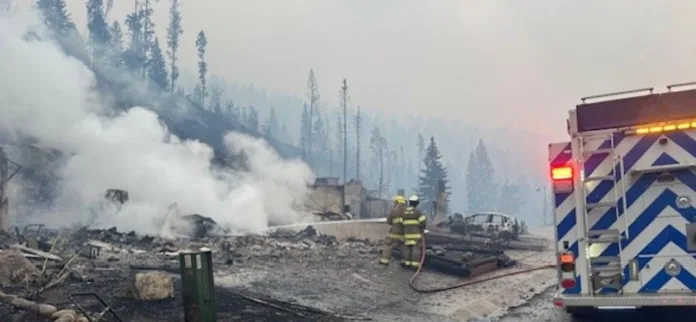A major wildfire tears through Jasper, Alberta, destroying about a third of the town, including homes, hotels, and local landmarks
Jasper, Alberta, has been left reeling after a catastrophic wildfire engulfed approximately one-third of the town, devastating residential areas and landmarks. On July 26, 2024, Premier Danielle Smith, Jasper Mayor Richard Ireland, and other officials toured the charred remains to assess the damage firsthand.
The wildfire forced tens of thousands of residents and visitors to evacuate Jasper National Park, resulting in significant destruction across the town. The tour revealed the full extent of the disaster: hundreds of homes were reduced to rubble, the iconic Petro-Can gas station destroyed, and the Maligne Lodge levelled. The fire’s intensity left behind only the foundations and chimneys of homes, while personal belongings and vehicles lay in ruins.
Jasper Mayor Richard Ireland, facing the emotional wreckage of his own home, expressed the profound personal and community loss. Ireland’s family home of 67 years was among those destroyed, leaving only the foundation and remnants of cherished possessions. As he surveyed the scene, he reflected on the deep emotional impact of witnessing his lifelong memories reduced to ashes.
Premier Danielle Smith, who accompanied the tour, expressed her shock and sorrow at the scale of the destruction. She acknowledged the overwhelming nature of the damage and emphasized the need for community resilience and preparation for the long recovery ahead.
The wildfire, driven by high winds and extreme conditions, advanced rapidly, scorching around five kilometres in just an hour. Officials noted that the blaze, characterized by a crown fire that leapt from treetop to treetop, moved at an alarming rate of 15 meters per minute. Despite extensive preparations, the ferocity of the fire challenged the response efforts and highlighted the unpredictable nature of such disasters.
Parks Canada reported that about 30% of Jasper’s 1,113 structures were either damaged or destroyed, totalling 358 buildings. Despite the extensive damage, critical infrastructure, including the hospital, emergency services, schools, and wastewater treatment plant, remained intact.
The fire’s aftermath mirrors previous devastating wildfires in Alberta, such as those in Slave Lake in 2011 and Fort McMurray in 2016. As recovery efforts begin, the community of Jasper faces a long road ahead, grappling with the extensive damage and rebuilding from the destruction.
Analysis:
Political: The wildfire’s impact on Jasper has intensified scrutiny on governmental response and disaster preparedness. Premier Danielle Smith’s visit underscores the political challenge of addressing both immediate needs and long-term recovery. The disaster presents an opportunity for political leaders to demonstrate their commitment to disaster management and community support. The government’s handling of recovery efforts will likely influence public perception and could shape future policies on wildfire preparedness and climate change adaptation.
Social: The wildfire’s devastation highlights the profound social impact of such natural disasters. The destruction of homes and landmarks in Jasper affects not only the physical landscape but also the community’s sense of identity and belonging. The loss of personal possessions and historical sites deepens the emotional toll on residents. Social resilience and community solidarity will play crucial roles in the recovery process, as residents come together to rebuild their lives and restore their town.
Racial: Although the immediate reporting does not specify racial impacts, the broader context of wildfire devastation often involves diverse communities. Indigenous populations, in particular, may experience compounded effects due to existing socio-economic challenges and land management issues. Ensuring equitable support for all affected communities, including addressing any unique needs of Indigenous groups, will be essential in the recovery and rebuilding phases.
Gender: The wildfire’s impact on gender dynamics in Jasper could be significant, particularly in terms of family responsibilities and community roles. Women, often primary caregivers and community organizers, may face increased burdens as they manage recovery efforts while also supporting their families. The response to the disaster should consider the specific needs of women and ensure that gender-sensitive approaches are integrated into recovery and support services.
Economic: The economic repercussions of the wildfire are substantial. The destruction of homes, businesses, and landmarks will likely result in significant financial losses for residents and the local economy. The cost of rebuilding and recovery will strain public resources and insurance systems. Additionally, the temporary displacement of residents and disruption to tourism may have long-term economic effects. The government’s response will need to address both immediate economic relief and long-term recovery strategies to support the affected community.
